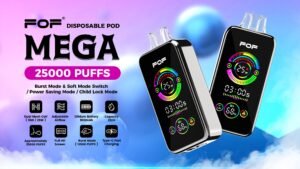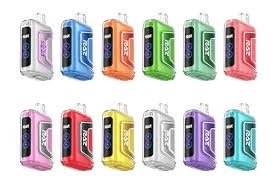Walking into a corner shop to buy your first vape can feel intimidating and confusing. With countless options on display and unfamiliar terminology, many first-time buyers end up with products that don't meet their needs or expectations.
When buying a vape at a corner shop, you should ask about device type (pod system, disposable, or pen style), nicotine strength options, battery life, coil replacement, flavor varieties, and price of ongoing supplies. For beginners, corner shops typically offer limited but accessible options compared to dedicated vape stores.

"Vape selection at corner shop"
During my years in the vape manufacturing business, I've seen how corner shops have become increasingly important sales channels for vape products. While they don't offer the expertise or selection of dedicated vape shops, they provide convenience and accessibility that many users value. This guide will help you navigate the corner shop vape buying experience with confidence, ensuring you ask the right questions to get a product that serves your needs.
What to Look For When Buying a Vape?
Feel overwhelmed by the colorful packaging and technical terms on vape products? Worried you might waste money on something unsuitable? Knowing these key factors will help you cut through the marketing hype.
When buying a vape, look for appropriate device type for your experience level, suitable nicotine strength, adequate battery capacity, reasonable price-to-quality ratio, and legitimate manufacturer branding. In corner shops, focus on recognizing quality brands and avoiding counterfeits, as selection will typically be limited.

"Various vape types and brands"
Throughout my career working with vape retailers, I've noticed that corner shops typically stock three main categories of vape products: disposable vapes1, prefilled pod systems2, and occasionally simple refillable devices. Understanding these categories is your first step toward making an informed purchase.
Disposable vapes are complete units designed to be discarded after the battery dies or the e-liquid is depleted. They require zero maintenance and come ready to use right out of the package. The convenience factor is extremely high, but the long-term cost and environmental impact are significant drawbacks. In corner shops, these are often displayed prominently due to their high profit margins and appeal to casual users.
Prefilled pod systems consist of a rechargeable battery section and replaceable pods containing e-liquid and a coil. These offer better battery life than disposables and lower long-term costs, though they're still more expensive than refillable systems. Most corner shops carry at least one or two popular brands, typically with limited pod flavor options compared to vape shops.
Refillable pod systems or simple pen-style devices might be available in some corner shops, though selection is usually minimal. These devices allow you to use any compatible e-liquid, offering more flexibility and significantly lower running costs. However, they require more knowledge about coil replacement and e-liquid selection.
When examining devices, check for these quality indicators:
The packaging should include manufacturer details, batch numbers, and authentic verification codes. Legitimate products typically have security features to prevent counterfeiting. The JUUL verification scratch-off code is a good example of this authentication method.
The build quality should feel solid with no rattling parts or loose connections. Even budget devices should have a certain weight and sturdiness to them. Buttons should click firmly, and removable parts should fit together precisely.
Battery capacity is typically measured in milliampere-hours (mAh). For disposables, higher mAh ratings indicate longer lifespans. For rechargeable devices, look for at least 350mAh for pod systems and 1000mAh+ for larger devices to avoid frequent recharging.
Coil options matter even in simple devices. Some corner shop vapes offer different coil resistances for different vaping styles. Lower resistance coils (below 1.0 ohm) produce more vapor but consume more battery and e-liquid. Higher resistance coils (above 1.0 ohm) are more suitable for nicotine salts and provide a more cigarette-like experience.
Price considerations should include not just the initial device cost but ongoing expenses. A $10 disposable might seem cheaper than a $25 refillable pod system, but the refillable system could save you money within just a week of use. Calculate the total cost of ownership before deciding.
| Device Type | Initial Cost | Monthly Cost Estimate | Best For |
|---|---|---|---|
| Disposables | $8-20 each | $60-240 (heavy usage) | Ultimate convenience, trying vaping, occasional use |
| Prefilled Pod Systems | $15-35 device, $10-20 pod packs | $40-120 | Regular vapers who value convenience over cost |
| Refillable Systems | $20-50 device, $15-25 supplies | $20-60 | Cost-conscious regular vapers willing to learn basic maintenance |
Corner shops typically focus on current trends rather than long-term reliable products. This means you'll often find the latest disposable brands rather than established quality devices. When possible, use your smartphone to quickly research any unfamiliar brand before purchasing. A few minutes of research can prevent disappointment and wasted money.
What Are Good Questions to Ask About Vaping?
Do you feel hesitant to ask questions because you don't want to seem uninformed? Unsure what information you need to make a good decision? These essential questions will help you gather critical information without requiring extensive vaping knowledge.
Good questions to ask when buying a vape include: Which device do you recommend for beginners? What nicotine strength matches my smoking habits? How long does the battery typically last? How often will I need to buy replacement parts? What's your return policy if I'm unsatisfied? These questions address the most common pain points new vapers experience.

"Customer inquiring about vape products"
Having trained countless vape retailers, I've developed a list of essential questions that every buyer should ask, especially at corner shops where staff may have limited product knowledge. Don't be shy about asking these questions—they demonstrate that you're a thoughtful consumer rather than suggesting inexperience.
"Which device would you recommend for someone just starting with vaping?" This open-ended question gives the seller an opportunity to demonstrate their knowledge (or lack thereof). A knowledgeable seller will ask about your smoking habits before recommending specific products, while someone with limited expertise might push whatever has the highest profit margin regardless of suitability.
"What nicotine strength3 would match my current smoking habits?" Your nicotine strength needs depend on your previous tobacco usage. As a general rule, pack-a-day smokers typically start with higher strengths (25-50mg nicotine salts), light smokers do well with medium strengths (9-18mg), and occasional smokers might prefer low strengths (3-6mg). If the seller recommends the same strength for everyone, that's a red flag.
"How long does this battery typically last before needing a recharge?" Battery life claims on packaging are often optimistic. Ask for real-world expectations based on regular usage. For disposables, ask how many puffs or days the average user gets before the device is depleted. For rechargeable systems, ask about typical usage time between charges.
"How much do replacement pods/coils cost4, and how often will I need to replace them?" This question helps you understand the true cost of ownership. Replacement pods might cost $10-20 for a pack of 2-4, with each pod lasting 3-10 days depending on usage patterns and juice characteristics. Calculate your monthly operating costs before committing to a system.
"Do you carry a variety of flavors for this device, or would I need to go elsewhere for more options?" Corner shops typically stock limited flavor options compared to dedicated vape shops or online retailers. Understanding the available flavor selection helps you determine whether this purchase location will meet your long-term needs.
"What's your return policy if I'm not satisfied with this device?" This critical question is often overlooked. Some shops have strict no-return policies for vape products, while others might offer exchanges for defective items. Knowing the policy before purchasing provides important consumer protection.
"Is this a genuine product from the original manufacturer?" Counterfeit vapes are a serious problem, particularly with popular brands. Legitimate sellers should be able to verify authenticity through codes, authorized distributor relationships, or other means. If they can't confirm authenticity, consider shopping elsewhere.
"What safety features does this device have?" Important safety features5 include short-circuit protection, low-voltage protection, and overcharge protection. Quality devices incorporate multiple safety mechanisms to prevent battery issues and other hazards. If the seller can't speak to these features, they may not be selling quality products.
For corner shop purchases specifically, also ask:
"How long have you been carrying this brand?" Established relationships with suppliers often indicate legitimate supply chains rather than gray market products.
"Which products are most popular with your regular customers?" This reveals which products have earned repeat customers, a good indicator of satisfaction and reliability.
"Do you help with setting up the device or troubleshooting issues?" Some corner shops offer minimal post-purchase support, while others pride themselves on helping customers succeed with their purchases.
What Should I Get For My First Vape?
Paralyzed by too many choices? Afraid of buying something too complicated or unsuitable? First-time purchases should balance simplicity with satisfaction—here's how to find that sweet spot.
For your first vape purchase from a corner shop, consider a reputable pod system like JUUL, Vuse, or NJOY, or a quality disposable from brands like Elf Bar or Hyde. Look for simple operation, appropriate nicotine strength, and reasonable cost. Avoid overly complex devices or suspiciously cheap options that might offer poor quality or satisfaction.

"Beginner-friendly vape devices"
Based on my experience helping thousands of smokers transition to vaping, I've found that first-time users have the most success with simple, satisfying devices that minimize the learning curve. Corner shops typically offer a smaller selection than dedicated vape shops, but you can still find good starter options if you know what to look for.
Pod-based systems6 represent the ideal starting point for most new vapers. Systems like JUUL, Vuse Alto, or NJOY Ace offer cigarette-like experiences with minimal complexity. These devices activate automatically when you inhale (no buttons to press) and use prefilled pods that eliminate the need to handle e-liquid. While not the most economical long-term option, they provide a hassle-free introduction to vaping that closely mimics the smoking experience.
Quality disposable vapes can also serve as good introductory devices. Brands like Elf Bar, Hyde, Puff Bar, or Geek Bar offer ready-to-use experiences with no maintenance requirements. They're ideal for testing whether vaping suits you before investing in a more permanent system. Look for disposables with at least 400mAh battery capacity and 2ml or more e-liquid to ensure reasonable usage duration.
Simple refillable pod systems might be available at some corner shops and offer a more economical introduction to vaping. The Uwell Caliburn series, Vaporesso XROS, or SMOK Novo represent good options if available. These require learning to refill tanks and replace coils but offer significantly lower running costs than prefilled systems or disposables.
For your first device, prioritize these features:
Draw-activation (automatic firing when you inhale) eliminates one potential point of confusion and makes the experience more intuitive for former smokers. While button-activated devices offer more control, they require learning proper operation and safety procedures.
Nicotine salt compatibility7 is important for smokers seeking a similar nicotine satisfaction level. Nicotine salts deliver nicotine more efficiently and with a smoother throat hit than traditional freebase nicotine, helping to satisfy cravings more effectively for those transitioning from cigarettes.
Leak resistance8 should be a top priority. Early vaping experiences can be ruined by leaking devices that waste expensive e-liquid and create messes in pockets or bags. Pod-based systems generally offer better leak protection than older tank designs.
Battery indicators help prevent the frustration of unexpected power depletion. Look for devices with LED indicators that clearly show remaining battery life, allowing you to charge before completely running out of power at inconvenient moments.
Portability matters for practical everyday use. Your first device should easily fit in a pocket or small bag compartment. Bulky devices might offer more features but often end up left at home due to inconvenience.
I recommend avoiding these first-time purchase mistakes:
Don't buy the cheapest option available. While budget constraints are real, ultra-cheap devices often deliver disappointing experiences that may lead you back to smoking. A slightly higher investment in a quality starter device significantly increases your chances of successful transition.
Avoid overly complex devices for your first purchase. Features like variable wattage, temperature control, or rebuildable coils add complexity that can overwhelm beginners. Start simple and upgrade later as you become more familiar with vaping.
Don't automatically choose the highest nicotine strength. Match the strength to your smoking habits to avoid uncomfortable experiences. Too much nicotine can cause headaches and nausea, while too little may leave cravings unsatisfied.
| Experience Level | Recommended Device Type | Example Products | Approximate Cost |
|---|---|---|---|
| Complete Beginner | Disposable or Pod System | Elf Bar, JUUL, Vuse Alto | $10-35 |
| Beginner with Some Research | Refillable Pod System | Uwell Caliburn, SMOK Novo | $20-40 |
| Former Smoker (Heavy) | Higher Nicotine Pod System | JUUL (5%), Vuse Alto (5.0%) | $15-40 |
| Former Smoker (Light) | Lower Nicotine Options | Disposables/Pods (1.8-3%) | $10-35 |
Is It Okay for a 16-Year-Old to Vape?
Curious about age restrictions? Wondering about legal and health implications for younger users? Understanding the regulations and research is essential before making decisions about vaping for minors.
No, it is not okay for a 16-year-old to vape. In most countries, vaping products are legally restricted to adults 18 or 21 years and older. Beyond legal concerns, developing adolescent brains are particularly vulnerable to nicotine's effects, potentially impacting attention, learning, mood regulation, and impulse control.

"Vape product age restriction notice"
As both a vape manufacturer and concerned industry professional, I take the issue of youth vaping9 extremely seriously. The legal landscape is clear: in the United States, federal law prohibits the sale of all vaping products to anyone under 21 years of age through the "Tobacco 21" legislation. In the UK, EU countries, Canada, and most other nations, the minimum age is 18. These age restrictions exist for important health and developmental reasons.
The scientific evidence regarding adolescent nicotine exposure is concerning. Nicotine affects brain development10, which continues until approximately age 25. Adolescent brains are particularly sensitive to nicotine's effects, with research showing that early nicotine exposure can alter neural pathways related to addiction, cognition, and emotional regulation. These changes may have long-lasting consequences beyond the immediate effects of nicotine.
The FDA and similar international regulatory bodies have not approved vaping as a smoking cessation tool for adolescents. While some adults find vaping helpful for quitting combustible cigarettes, this harm reduction approach is not applicable to non-smoking youth who would otherwise remain nicotine-free. Beginning vaping as a teenager introduces nicotine addiction rather than addressing an existing one.
Responsible corner shops and all legitimate vape retailers should have strict age verification procedures in place. This typically includes checking government-issued photo ID for anyone who appears under 30 and refusing sales to minors regardless of circumstances. If a corner shop sells vape products without age verification, they are violating the law and potentially contributing to youth nicotine addiction.
Parents should be aware that early vaping introduction is associated with increased risk of transitioning to other substances. While not all teen vapers progress to other substance use, longitudinal studies indicate elevated risk compared to non-vaping peers. The "gateway effect11" remains debated among researchers, but the correlation warrants serious consideration.
For parents concerned about teen vaping, here are evidence-based approaches:
Open communication about vaping should focus on health impacts rather than scare tactics. Teenagers respond better to factual information than exaggerated claims. Discuss how nicotine specifically affects developing brains differently than adult brains.
Recognize risk factors that increase likelihood of experimentation, including peer vaping, stress, mental health challenges, and academic pressure. Address these underlying issues rather than focusing solely on the vaping behavior itself.
Set clear expectations and consequences regarding vaping. Consistent, fair boundaries help teenagers make better decisions when facing peer pressure or temptation.
Provide healthy alternative coping mechanisms for stress, anxiety, and social situations—the common triggers for adolescent substance use. Sports, creative outlets, and social activities can fulfill similar psychological needs.
If you discover your teenager is already vaping, approach the situation as a health issue rather than a disciplinary problem. Focus on understanding their motivations and helping them develop strategies to quit, potentially involving healthcare providers for support.
| Concern | Scientific Evidence | Practical Implication |
|---|---|---|
| Nicotine & Brain Development | Strong evidence of altered neural pathways | Potential long-term impacts on learning, memory, and attention |
| Addiction Vulnerability | Research shows adolescents develop dependence more rapidly than adults | Higher likelihood of developing long-term nicotine addiction |
| Gateway Effect | Moderate evidence of correlation with other substance use | Increased risk for experimentation with other substances |
| Lung Development | Emerging evidence of potential respiratory impacts | Possible effects on developing respiratory system |
| Mental Health | Studies show bidirectional relationship with anxiety/depression | May exacerbate existing mental health challenges |
The argument that "vaping is better than smoking" misses a crucial point for adolescents: the comparison isn't relevant for those who wouldn't otherwise smoke. While vaping appears less harmful than combustible cigarettes for adult smokers, this harm reduction framework doesn't apply to non-smoking teens. For them, the comparison should be between vaping and remaining nicotine-free, where the evidence clearly favors abstinence.
Some teens mistakenly believe that nicotine-free vape liquids eliminate health concerns. However, studies have found that many "nicotine-free" products actually contain nicotine when tested independently. Additionally, other chemicals in vape aerosol may pose respiratory risks regardless of nicotine content. The flavoring compounds, while generally recognized as safe for ingestion, haven't been adequately studied for inhalation safety over the long term.
In my manufacturing experience, I've observed how product design and marketing can influence youth appeal, which is why responsible manufacturers implement strict marketing guidelines. Parents and educators should be particularly wary of brightly colored devices, candy or dessert flavors with youth-oriented naming conventions, and products featuring cartoon characters or youth-culture references. These design elements often signal products that may intentionally or unintentionally appeal to younger users.
For corner shop owners reading this article, I strongly encourage implementing robust age verification systems—not just because it's the law, but because it's ethically imperative. My company and other responsible manufacturers refuse to supply retailers with documented histories of selling to minors. The industry's long-term sustainability depends on keeping these products strictly in adult hands.
Conclusion
When buying your first vape from a corner shop, focus on reputable brands, appropriate nicotine strength, and simple operation. Ask knowledgeable questions about battery life, replacement costs, and product authenticity. Remember that vaping is strictly an adult activity, with both legal restrictions and health concerns making it inappropriate for anyone under 18 or 21, depending on your location.
|---
-
Explore this resource to understand the benefits and drawbacks of disposable vapes, aiding your decision-making process. ↩
-
Learn about prefilled pod systems to see if they fit your vaping needs and preferences, enhancing your vaping experience. ↩
-
Understanding nicotine strength is crucial for a satisfying vaping experience. Explore this link to learn more about choosing the right strength for you. ↩
-
Knowing the cost of replacement pods and coils helps you budget for your vaping needs. Check this resource for detailed pricing information. ↩
-
Safety is paramount in vaping. Discover essential safety features to ensure a secure vaping experience by exploring this informative link. ↩
-
Explore this link to discover top-rated pod-based systems that provide a seamless transition for new vapers, ensuring a satisfying experience. ↩
-
Understanding nicotine salt compatibility can enhance your vaping experience, making it smoother and more satisfying for former smokers. ↩
-
Learn about the importance of leak resistance in vape devices to avoid messy situations and ensure a hassle-free vaping experience. ↩
-
Understanding the health impacts of youth vaping is crucial for parents and educators to address this growing concern effectively. ↩
-
Exploring the effects of nicotine on adolescent brain development can provide insights into the risks associated with early vaping. ↩
-
Learning about the gateway effect can help parents and professionals understand the potential risks of teen vaping leading to other substance use. ↩






